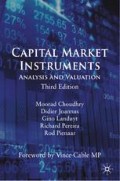Abstract
Equity instruments call for a different approach in their analysis compared with debt securities. Compared with conventional bonds, shares do not pay a fixed cash flow during their life and do not have a fixed maturity date. Instead, the future cash flows of shares cannot be determined with certainty and must be assumed, and as they are in effect perpetual securities they have no redemption value. In addition they represent a higher form of risk for their holders. The analysis and valuation of shares therefore call for different techniques from that of bonds. In addition the interests of shareholders and bondholders sometimes often sit on opposite ends of the risk spectrum. While a firm’s bondholders are to some extent primarily concerned with financial probity and the maintenance (or upgrade) of its credit rating, shareholders gain, at least in the short term, from high-risk and high-return strategies where favourable perceptions lead to a short-term rise in the share price.
Access this chapter
Tax calculation will be finalised at checkout
Purchases are for personal use only
Preview
Unable to display preview. Download preview PDF.
Selected bibliography and references
Choudhry, M. The Bond and Money Markets: Strategy, Trading, Analysis, Butterworth-Heinemann, 2001.
Gordon, M. The Investment, Financing and Valuation of the Corporation, Irwin, 1962.
Higson, C. Business Finance, 2nd edition, Butterworths, 1995.
Mills, R. and Robertson, J. Fundamentals of Managerial Accounting and Finance, Mars Business Associates, 1995.
Modigliani, F. and Miller, M. ‘Dividend policy, growth and the valuation of shares’, Journal of Business, 34, 1961, pp. 411–33.
Ross, S. ‘The arbitrage theory of capital pricing’, Journal of Economic Theory, December 1976, pp. 343–62.
Rozeff, M. ‘The dividend discount model’, Journal of Portfolio Management, Winter 1977.
Sharpe, W., Alexander, G. and Bailey, J. Investments, Prentice Hall, 1995.
Van Horne, J. Financial Management and Policy, 10th edn, Prentice Hall, 1995.
Author information
Authors and Affiliations
Copyright information
© 2010 Moorad Choudhry, Didier Joannas, Gino Landuyt, Richard Pereira and Rod Pienaar
About this chapter
Cite this chapter
Choudhry, M., Joannas, D., Landuyt, G., Pereira, R., Pienaar, R. (2010). Introduction to Equity Instrument Analysis. In: Capital Market Instruments. Palgrave Macmillan, London. https://doi.org/10.1057/9780230279384_21
Download citation
DOI: https://doi.org/10.1057/9780230279384_21
Publisher Name: Palgrave Macmillan, London
Print ISBN: 978-0-230-57603-2
Online ISBN: 978-0-230-27938-4
eBook Packages: Palgrave Economics & Finance CollectionEconomics and Finance (R0)

